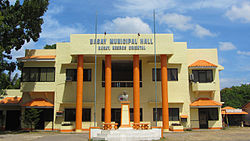
Back Basay BCL Basay (Filipines) Catalan Basay CBK-ZAM Basay, Negros Oriental CEB Basay (Negros Oriental) German Basay Spanish Basay (Negros oriental) French Basay, Negros Timur ID Basay, Negros Oriental ILO Basay (Negros Oriental) Italian
Basay | |
|---|---|
| Municipality of Basay | |
 Municipal Hall | |
 Map of Negros Oriental with Basay highlighted | |
Location within the Philippines | |
| Coordinates: 9°25′N 122°38′E / 9.42°N 122.63°E | |
| Country | Philippines |
| Region | Negros Island Region |
| Province | Negros Oriental |
| District | 3rd district |
| Founded | June 15, 1968 |
| Named for | Visayan term "busay", meaning "spring" |
| Barangays | 10 (see Barangays) |
| Government | |
| • Type | Sangguniang Bayan |
| • mayor of Basay[*] | Fatima C. Cañamaque (NPC) |
| • Vice Mayor | Jonny A. Wagas (IND) |
| • Representative | Vacant (Martin Romualdez serves as legislative caretaker) |
| • Municipal Council | Members |
| • Electorate | 20,506 voters (2022) |
| Area | |
• Total | 162.00 km2 (62.55 sq mi) |
| Elevation | 74 m (243 ft) |
| Highest elevation | 686 m (2,251 ft) |
| Lowest elevation | 0 m (0 ft) |
| Population (2020 census)[3] | |
• Total | 28,531 |
| • Density | 180/km2 (460/sq mi) |
| • Households | 6,984 |
| Economy | |
| • Income class | 4th municipal income class |
| • Poverty incidence | 40.12 |
| • Revenue | ₱ 120.9 million (2020) |
| • Assets | ₱ 220.8 million (2020) |
| • Expenditure | ₱ 113.9 million (2020) |
| • Liabilities | ₱ 38.07 million (2020, 2019) |
| Service provider | |
| • Electricity | Negros Oriental 2 Electric Cooperative (NORECO 2) |
| Time zone | UTC+8 (PST) |
| ZIP code | 6222 |
| PSGC | |
| IDD : area code | +63 (0)35 |
| Native languages | Cebuano Tagalog Hiligaynon |
Basay, officially the Municipality of Basay, is a 4th class municipality in the province of Negros Oriental, Philippines. According to the 2020 census, it has a population of 28,531 people.[3]
The town is home to the highly significant Minagahat language, the indigenous language of Southern Negros as listed by the Komisyon ng Wikang Filipino. The language is vital to the culture and arts of the people.
Basay is 122 kilometres (76 mi) from Dumaguete.
- ^ Municipality of Basay | (DILG)
- ^ "2015 Census of Population, Report No. 3 – Population, Land Area, and Population Density" (PDF). Philippine Statistics Authority. Quezon City, Philippines. August 2016. ISSN 0117-1453. Archived (PDF) from the original on May 25, 2021. Retrieved July 16, 2021.
- ^ a b Census of Population (2020). "Region VII (Central Visayas)". Total Population by Province, City, Municipality and Barangay. Philippine Statistics Authority. Retrieved 8 July 2021.
- ^ "PSA Releases the 2021 City and Municipal Level Poverty Estimates". Philippine Statistics Authority. 2 April 2024. Retrieved 28 April 2024.


